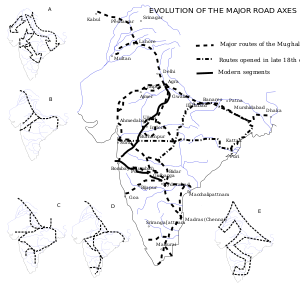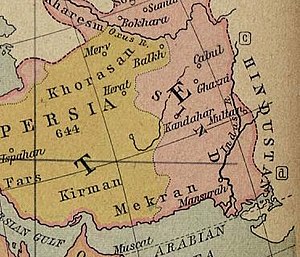Delhi–Multan road

Delhi Multan Road (Template:Lang-ur), ancient route had existed since the time of king Ashoka or earlier, was renovated by the Delhi Sultanate ruler Sher Shah Suri (1486–1545) in order to improve transit in the areas between Delhi and Multan, leading to Kandhar and Herat in Afghanistan, eventually to Mashhad capital of Khorasan province of Iran, providing access to capital city Ashgabat of Turkmenistan."[1]
Messaging System

There were small posts every few miles where horses were ready to receive messages to send from one post to another. Messages from the Delhi court were reaching Multan, which was around 500 miles away, within days.[1]
Route
On the Indian side, it passed through Rohtak, Meham, Asigarh Fort at Hansi, Firoz Shah Palace Complex at Hisar, Fatehabad, Ratia, Bhatinda and Malout, etc.
On the Pakistani side, the road goes through the cities Pakpattan, Arifwala, Gaggoo, Burewala, Vehari and finally Multan. Some parts of this road are still in use in Pakistani areas and the road leading from Pakpattan to Multan still bears the name of Delhi Multan road. Punjab Road Transport Department still uses this name on its milestones in this area.
In Afghanistan, from Multan it led to Kandhar and then on to Herat.
In Iran, from Herat it led to capital city Mashhad of Khorasan province of Iran.
In Turkmenistan, from Mashhad it eventually led to capital city Ashgabat of Turkmenistan.
Gallery
-
An accurate map of Persia by Emanuel Bowen showing the names of territories during the Persian Safavid dynasty and Mughal Empire of India (ca. 1500–1747)
See also
- Grand Trunk Road: Delhi-Lahore-Kabul road
References
- ^ a b "Khurasan", The Encyclopaedia of Islam. Brill. Retrieved 2010-10-22.

